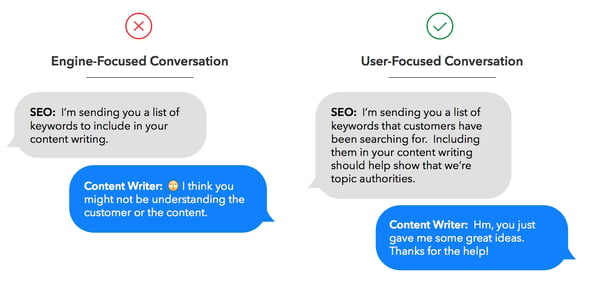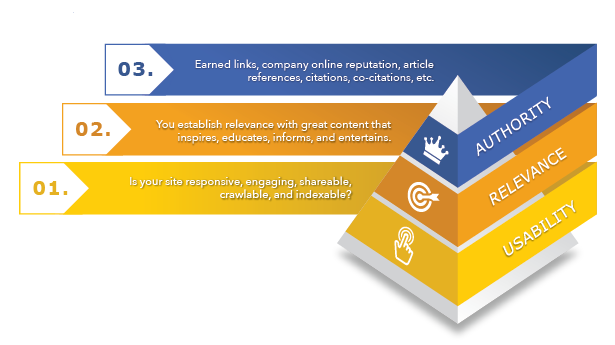Here's what I'll cover in this post:
- What Makes Enterprise SEO Successful
- The Growth Stages of In-House SEO
- Reaching Repeatable Results in Organic Search
What Makes Enterprise SEO a Success?
SEO is more than just adding keywords to pages. Successfully positioning an enterprise-level website in search and then, increasing its search visibility requires:
- Managing and overseeing the entire strategy,
- Conducting technical audits,
- Creating content marketing strategies,
- Training key strategy stakeholders,
- Analyzing and reporting on the performance,
- Collaboration across dispersed teams, and
- Most importantly, evangelizing the role of SEO for the organization.
None of which is a small feat, as I’m sure you agree.
In my experience working with SEO managers, there are different ways they manage their SEO campaigns successfully.
Some rely heavily on SEO agencies for guidance but often also their campaign delivery. Others believe it's better to have their SEO in-house; they see agencies as disconnected and prefer to utilize internal resources only.
Companies that rely heavily on an agency often face a serious challenge: they still have to do what the SEO specialist at the agency recommends — a hard task to complete without resources to produce all of the necessary assets and implement insights an agency provided.
For the purpose of this post, I'll focus on in-house SEO teams, and how they can work to educate the entire company on organic search.
The Three Growth Strategies of In-House SEO
Successful enterprises go through three growth stages of in-house SEO:
- Build the foundation.
- Accelerate those initiatives and spread SEO across the organization
- Use the above to advance the brand.
Stage 1: Build the SEO Foundation
The goal for the first stage is to jump-start your SEO, get the basics in place and show some quick wins.
In practical terms, this requires identifying goals for SEO, KPIs to monitor, and establishing baselines for reporting on analytics and your other efforts.
And for that, you need three elements: talent, tools, and training.
As an organization, you focus on the first group – the team members you bring in to own, run and, push the execution of SEO.
Recommended Reading: All-Star Cast of SEOs: Building a Winning In-House SEO Team
A platform like seoClarity helps with the remaining two. Tools and training help you accelerate and do whatever you need to do very quickly and easily. From insights, competitive benchmarks to reporting, workflows and consistency, the platform and our Client Success Team become the foundation of your efforts.
Stage 2: Accelerate Your Initiatives
As you start to spend time getting your initiatives off the ground, you need to make sure that everyone in the organization is aligned with the idea of SEO.
For enterprises especially, you need a strategic framework for decision-making that will allow new initiatives to move forward swiftly. And to achieve that, you need to break SEO free from a silo and align everyone involved to think similarly about it.
Recommended Reading: 9 Ways SEOs Bring Value to Every Team in Their Organization
For example, when you go to your IT person and talk to them about SEO, you most likely talk about things that aren’t aligned with their goals. They focus on a good and fast user experience first. As a result, they see SEO-related errors as a hindrance from working on what’s important to them.
Similarly, asking writers to include specific keywords might seem like stripping them of their creativity.

To break those barriers, you need to change the conversation away from engines and algorithms to:
- Delivering a terrific user experience
- Aligning SEO with overall corporate and individual stakeholder priorities
By changing the way you talk about SEO, you can impact how everyone else thinks about it — you make every search-related request relevant to your teams' goals, too. And what goes with it, simplify the decision whether to focus on it or not.
Stage 3: Advance the Brand
You’ve spread the word about SEO; you’ve put the talent in place — it's time to build simple, scalable workflows that deliver consistent and reliable results no matter which part of your organization or what site you’re working on. And for that, you need to develop what we refer to as the URA framework: Usability, Relevance, Authority.
This is a ground-up approach to SEO. You need to have a sound technical SEO foundation for your site (i.e. usability) before you can create authoritative content (i.e. relevance) that ranks well and earns backlinks (i.e. authority).

However, there’s more to this framework than just putting order to your SEO focus. It establishes the foundation for how everyone in the organization should think about it, too.
When you bring SEO in-house, you don’t want to make everyone an SEO expert. In fact, your key talent should be the only people with wide knowledge on the topic. Everyone else should be taught what they need to know, based on their roles, and how they can help support the SEO team.
Recommended Reading: The Road to SEO Expertise: Learning From the Veterans
By creating workflows and standard operating procedures, you create consistency across various outputs and channels that allows you to execute, track, analyze and tweak your strategies continuously.
How We Help: Repeatable Results in Organic Search
seoClarity is an enterprise-level SEO platform, but we're also so much more than just technology.
At seoClarity, we help you solve the challenge of tackling the hardest parts of enterprise SEO. In fact, we are here to structure, simplify, and scale your SEO.
What does that mean?
STRUCTURE
First, we help you put structure to how you approach SEO. This includes things like consolidating your metrics into one place. Then, you leverage the platform’s capabilities to extract the data and insights you need to create a thorough strategy.
SIMPLIFY
At first, every stakeholder is going to have their own view of SEO. A team in one country will consider one area of SEO as their primary focus, while another will want to work on something else, and so on.
By simplifying the processes for every role, you ensure a consistent approach to data analysis, insights, and knowledge-levels.
SCALE
This happens with repeatable workflows and best practices, plus continuous education about SEO that shifts the conversation from search engine optimization to search experience optimization.
But, Does it Work?
Let me show you the results of a survey we conducted on customers’ approach to SEO before and after they implemented SEO strategies with seoClarity's platform and framework.
Before using the platform, the majority of their time was spent on activities other than the actual execution – data gathering, analysis, reporting, and so on.
With seoClarity, it’s all about the execution – achieving greater and greater search visibility.

Conclusion
Any enterprise organization that wants to take their search visibility further must first and foremost bring the strategic control in-house. This means hiring in-house, evangelizing the channel across the organization, and using a platform that adds structure to data and insights they require.
Editor's Note: This blog was originally published in May 2018 and has been updated for accuracy and comprehensiveness.






Comments
Currently, there are no comments. Be the first to post one!